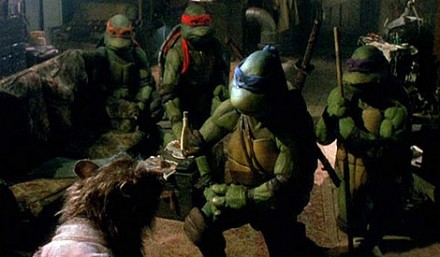To look at it from another angle, when was the last time you saw animatronics used in a real-life, face-to-face setting? Chuck E. Cheese's? Some ride at a theme park for a movie that left theaters fifteen or twenty years ago? Okay, I seem to recall encountering one or two robotic puppets at "The Wizarding World of Harry Potter", but they weren't true animatronics, just models of giant spiders attached to robotic arms.
Animatronics just don't seem to get the same amount of love they once did. The reasons for this are threefold:
1) animatronics are expensive, and once you've made one it's set in stone; you can't do a redesign if the creature doesn't test well with audiences;
2) animatronics contain thousands of moving parts, the malfunction of any one of which could cause the whole machine to cease working, leading to costly delays when filming must be halted while repairs are made; and
3) animatronics are subject to many of the same laws of physics which they attempt to overcome. For example, you can't build a three-story tall praying mantis animatronic for the same reason that a real three-story tall praying mantis wouldn't work: an insect that large simply could not support its own weight.
With these fairly major shortcomings in mind, it's no wonder that filmmakers have turned to CGI to satisfy their needs in the special-effects department.
But I feel that animatronic animals and characters have several advantages over CGI. Advantages which suggest that animatronic technology is not yet dead, nor yet completely outdated.
Number One: Animatronics will always look real.
This one gets swept under the rug a lot. When making a film, the director's primary concern is to get the movie finished on-deadline and under-budget. Everything else is secondary. But what director doesn't want their movies to look good for future audiences, when their films are being displayed by historical societies or film-school professors? The temptation to not just do well, but to leave landmarks for those who follow in one's footsteps is a powerful desire in many directors.
For proof, one simply needs to look at Star Wars.
 Pop a copy of Episode I into your DVD player, and take a good look at Jar-Jar Binks. (I know it hurts. Just bear with me for a moment.) Look at how he moves, how he interacts with the objects and actors around him. It doesn't quite look right, does it? Kinda... floaty, right? Like he's not really there? Jar-Jar was created just twelve years ago, using the most advanced CGI technology that had ever been assembled at that time. Barely a decade has passed, and he already looks fake.
Pop a copy of Episode I into your DVD player, and take a good look at Jar-Jar Binks. (I know it hurts. Just bear with me for a moment.) Look at how he moves, how he interacts with the objects and actors around him. It doesn't quite look right, does it? Kinda... floaty, right? Like he's not really there? Jar-Jar was created just twelve years ago, using the most advanced CGI technology that had ever been assembled at that time. Barely a decade has passed, and he already looks fake. Okay, now eject the disk, invite a priest over to purify your entertainment system, and pop in your DVD of Star Wars: A New Hope. Take a good hard look at Chewbacca. He looks really solid, doesn't he? He makes fluid motions, casts realistic shadow-effects, and has a palpable stage-presence. That movie is twenty years older than Episode I, yet Chewie still looks more realistic than Jar-Jar ever could. Why is this? It's because Chewbacca was actually there on the set! Which brings me to my next point,
Okay, now eject the disk, invite a priest over to purify your entertainment system, and pop in your DVD of Star Wars: A New Hope. Take a good hard look at Chewbacca. He looks really solid, doesn't he? He makes fluid motions, casts realistic shadow-effects, and has a palpable stage-presence. That movie is twenty years older than Episode I, yet Chewie still looks more realistic than Jar-Jar ever could. Why is this? It's because Chewbacca was actually there on the set! Which brings me to my next point,Number Two: Animatronics have superior stage-presence to purely-CGI characters.

When a CGI character interacts with a flesh-and-blood actor, in almost every case the actor was playing to an empty room, or a blank green-screen. As any actor will tell you, playing a part, any part at all, without another human presence to judge by and interact with, is an extremely difficult endeavor. Even if there was a man in a skintight greensuit standing where the monster's going to be in the final version, it's not the same as actually having the monster standing right in front of you, roaring and spitting venom in your face.
Number Three: Animatronic characters have a warmer, more human appearance.
Even if the character in question is not human at all, animatronics often induce much greater feelings of affection in audiences than any CGI character. Because the machines are bound by the same laws of physics as we are, their motions, by definition, look real and natural. While animators are busy trying to figure out how to convey a sense of weight and solidity in their creations, all a puppeteer needs to do is hit the "ON" switch and play around for a few minutes.

Furthermore, the fact that a puppeteer (or team of puppeteers) controls the machine's every motion means that all their motions will be infinitely more human. The animators don't need to search for the key to simulating natural movement; it's sitting right in front of them, waggling its ears and making faces at them.

"invite a priest over to purify your entertainment system"
ReplyDeleteI laughed. Nice arguments, SuperDave.